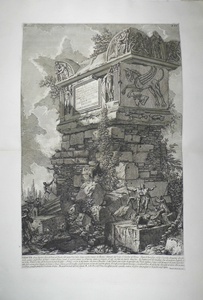| Method | Etching |
| Artist | Giovanni Battista Piranesi |
| Published | Piranesi Archit. dis. et. inc. |
| Dimensions | Image 600 x 390 mm, Plate 606 x 400 mm, Sheet 765 x 533 mm |
| Notes |
Plate XIV from the series Le Antichità Romane, a beautifully detailed image showing goats, herdsmen and other figures climbing around the dilapidated ancient tomb. A description of the tomb and its sculptures in Italian in the lower margin. The marble sarcophagus has been richly decorated with bas-reliefs, and can still be found today on the Via Cassia about five miles north of the centre of Rome. As is illustrated in the etching, the tomb is clearly identified as that of the consul, Publius Vibius Marianus. However, for many years the tomb was popularly believed to be that of the tyrannous Roman emperor, Nero, a legend that persisted until the nineteenth century, when the inscription was first pointed out to tourists visiting Rome. Even today, the district bears the name Tomba di Nerone. The Antichità Romane ('Roman Antiquities') was Piranesi's largest, and in many ways most ambitious, series of etchings, comprising 250 plates published in 4 volumes. Unlike the Vedute di Roma, the Antichità Romane is chiefly interested in small details, though the views of principal monuments in this work are no less aesthetically pleasing than the Vedute. Piranesi's agenda as an architect, namely the revival and emulation of classical Roman models, is immediately apparent in his meticulous recording of Rome's architectural and archaeological heritage. As a result, the Antichità Romane became a critical resource for antiquarians and academics. Piranesi's detailed explanations of Roman feats of engineering challenged the emergent argument for the superiority of Classical Greek models in art and architecture. Giovanni Battista (also Giambattista) Piranesi (1720 – 1778) was an Italian artist famous for his etchings of Rome and of fictitious and atmospheric "prisons" (the Carceri d'Invenzione). He was a major Italian printmaker, architect and antiquarian. The son of a Venetian master builder, he studied architecture and stage design, through which he became familiar with Illusionism. During the 1740's, when Rome was emerging as the centre of Neoclassicism, Piranesi began his lifelong obsession with the city's architecture. He was taught to etch by Giuseppe Vasi and this became the medium for which he was best known. Wilton-Ely 434, F299, C126 Condition: Excellent rich impression. Horizontal centre fold as issued. |
| Framing | unmounted |
| Price | £1,400.00 |
| Stock ID | 41876 |

